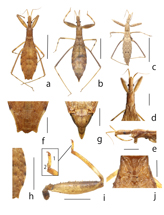Abstract
Sastrapada lativentralis sp. nov. is described based on specimens that were previously collected from Ryukyus, Japan, and during field surveys. Additional specimens were also obtained and photographed alive during a recent field survey in Ryukyus. This species is characterized by a distinctively broad abdomen and very shortened hemelytra. It can be distinguished from other species of Sastrapada Amyot & Serville, 1843, especially the related species S. brevicornis Breddin, 1900, S. brevipennis China, 1940, and S. microptera Miller, 1940, by the broader abdomen and the two-segmented protarsi. This new species is only known in the micropterous form at this time.
References
- Chen Z., Liu Y. & Cai W. 2020. Notes on the genus Enoplocephala Miller (Hemiptera: Reduviidae: Stenopodainae), with the description of a new species from Borneo. Raffles Bulletin of Zoology 68: 369–378. https://doi.org/10.26107/RBZ-2020-0053
- Davis N. T. 1966. Contributions to the morphology and phylogeny of the Reduvioidea (Hemiptera: Heteroptera). Part III. The male and female genitalia. Annals of the Entomological Society of America 59 (5): 911–924. https://doi.org/10.1093/aesa/59.5.911
- Diez F. & Coscarón M. C. 2014. The Stenopodainae (Hemiptera, Heteroptera) of Argentina. ZooKeys, (452): 51–77. https://doi.org/10.3897/zookeys.452.6519
- Gil-Santana H. R. 2012. Rhyparoclopius aokiae sp. nov., a remarkable Stenopodainae (Hemiptera: Heteroptera: Reduviidae) from Mato Grosso do Sul, Brazil, with taxonomical notes on other species of Rhyparoclopius Stål. Zootaxa 3478 (1): 93–104.
- Gil-Santana H. R., Forero D. & Weirauch C. 2015. Assassin bugs (Reduviidae excluding Triatominae). In: Panizzi AR, Grazia J. (Eds) True bugs (Heteroptera) of the neotropics. 2. Springer, Dordrecht: pp. 307–351. [ISBN 978-94-017-9860-0].
- Gil-Santana H. R. & de Oliveira J. 2016. Pratigi aristeui, a new Neotropical genus and species of Stenopodainae (Hemiptera: Heteroptera: Reduviidae). Acta Entomologica Musei Nationalis Pragae 56 (2): 491–505.
- Ha N. L., Truong X. L., Ishikawa T., Jaitrong W., Lee C. F., Chouangthavy B., & Eguchi K. 2022. Three new species of the genus Biasticus Stål, 1867 (Insecta, Heteroptera, Reduviidae, Harpactorinae) from Central Highlands, Vietnam. ZooKeys 1118: 133–180. https://doi.org/10.3897/zookeys.1118.83156
- Hsiao T. Y. & Ren S. Z. 1981. Reduviidae. pp. 390–538, pls. 55–81.In: A handbook for the determination of the Chinese Hemiptera-Heteroptera. Vol. II. (Hsiao, T. Y., Ren, S. Z., Zheng, L. Y., Jing, H. L., Zou, H. G. & Liu, S. L.,editors.), Science Press, Beijing, 654pp. (In Chinese, English summary)
- Ishikawa T. 2016. Family of Reduviidae. In: Hayashi M. Tomokuni M., Yoshizawa K. & Ishikawa T. (Eds.), Catalogue of the insects of Japan. Vol. 4 Paraneoptera. Touka-shobo, Fukuoka, pp. 439–452 (In Japanese).
- Ishikawa T. & Miyamoto S. 2012. Family Reduviidae Latreille, 1807. pp. 231–288, pls. 20–51. In: A field guide to Japanese bugs. Terrestrial heteropterans III (Ishikawa T., Takai M., & Yasunaga T., editors). Zenkoku Noson Kyoiku Kyokai, Tokyo, 573pp (In Japanese).
- Maldonado Capriles J. 1990. Systematic catalogue of the Reduviidae of the world (Insecta: Heteroptera). Caribbean Journal of Science, Special ed., pp. 694.
- Miller N. C. E. 1940. New genera and species of Malaysian Reduviidae. Part 1. Journal of the Federated Malay States Museum 18: 422–599.
- Miller N. C. E. 1948. New genera and species of Reduviidae from The Philippines, Celebes and Malaysia. Transactions of the Royal Entomological Society of London. 99(13): 411–473.
- Miller N. C. E. 1954. New genera and species of Reduviidae (Hemiptera-Heteroptera) from the Indo-Australian region. Treubia 22: 407–452.
- Naka T. 2016. New distribution records of eight assassin bugs (Reduviidae) from the Ryukyus, Japan. Rostria (59): 57–60. (In Japanese).
- Nakamura R. & Okuda K. 2021. First Record of the Assassin Bug Genus Neothodelmus Distant (Hemiptera: Heteroptera: Reduviidae) from Japan. Japanese journal of systematic entomology, 27 (2): 321–323.
- Okuda K. 2020a. Heteroptera (Insecta: Hemiptera) from Midori-Ku, Saitama City, Saitama Prefecture, Japan. Bulletin of the Saitama Museum of Natural History, 14, 43–52. (In Japanese). https://doi.org/10.24715/smnh.14.0_43.
- Okuda K. 2020b.Observation of the predation by Oncocephalus breviscutum Reuter, 1882 in the field. Yosegaki, (179): 39. (In Japanese).
- Schuh R. T. & Weirauch C. 2020. True bugs of the world (Hemiptera: Heteroptera): classification and natural history (Second Edition). Siri Scientific press, Manchester, UK, 767 pp.
- Shorthouse 2010. An online tool to produce publication-quality point maps. URL: https://www.simplemappr.net. (Accessed on: 2022-7-3).
- Swanson D. R. & Chordas S. W. I. 2018. Annotated list of the assassin bugs (Heteroptera: Reduviidae) of Belize, with the description of two new species. Zootaxa 4500 (3): 397–425. https://doi.org/10.11646/zootaxa.4500.3.7
- Tanaka Y., Ogaki K. & Maeda Y. 2013. Insects recorded in Ukejima-Is., Amami-islands. Research report of Itami City Museum of Insects Vol.1. p13–17. (In Japanese). https://doi.org/10.34335/itakon.1.0_13
- Villiers A. 1948. Faune de l’Empire Français. IX. Hémiptères Réduviidés de l’Afrique noire. Éditions du Muséum, Paris, 488 pp.
- Villiers A. 1968. Faune de Madagascar. XXVIII. Insects, Hémiptères, Reduviidae (1ère partie). Office de la Recherche Scientifique et Technique Outre-Mer, Centre National de la Recherche Scientifique, Paris, 198 pp.
- Weirauch C. 2008. Cladistic analysis of Reduviidae (Heteroptera: Cimicomorpha) based on morphological characters. Systematic Entomology 33 (2): 229–274. https://doi.org/10.1111/j.1365-3113.2007.00417.x


